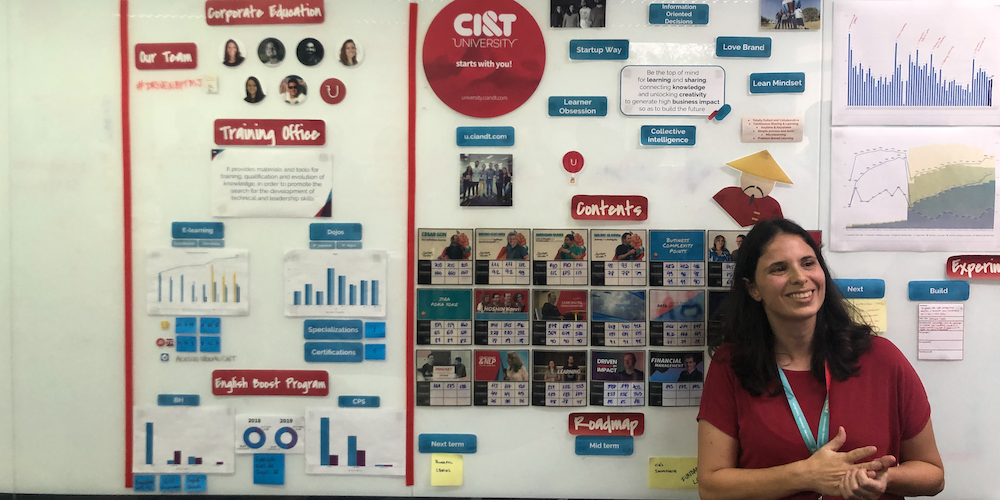
Can lean help with a brutal drop in sales?
FEATURE – With lockdowns enforced in many countries as Covid-19 continues to ravage the world, the authors discuss how Lean Thinking can help when the order book dries up.
Words: Michael Ballé and René Aernoudts
Examples of lean companies that experienced a sudden 50%+ drop in turnover this spring due to the Covid-19 pandemic abound. We have come across so many of them. In one case, after the lockdown, sales doubled for a couple of months (customers catching up on their purchases), before returning to their average level in the fall. In two others, business-to-business situations, contracts have been postponed to next year – the 2020 turnover will be half what it usually is but next year’s will hopefully be good. In the fourth case, supplying to aerospace and luxury markets, sales are still down and with no clear future in sight. The last company had just been purchased and started its new existence with a zero-order book.
Faced with such a challenge, Lean Thinking starts with mura (variation) – muri (overburden) – muda (waste). Obviously, going through it is a very different experience to witnessing it from the outside. For these CEOs, stepping back meant asking two fundamental questions:
- How serious is the challenge?
- What will be the impact of our reactions?
They were caught between the twin risks of either overreacting or not reacting fast enough. Clearly, the overburden would be on profitability – with a rapid drop in sales and no way to flex costs to that level, the brunt on the impact will come to bear on profit.
Following Lean Thinking, CEOs looked at their profitability over five years, not the usual yearly accounted cycle, and quickly came to the conclusion that the real problem was not profit – this was survivable in any circumstances for at least one year – but cash. Very quickly they resolved not to fire anyone or break off relationships with key suppliers, but to practice teamwork: explain the problem to everyone and engage them in creative thinking about preserving cash – and yes, this meant canceling or postponing some activities as well.
Interestingly, this led to postponing investments more than reducing costs. Many mainstream businesses have had the knee-jerk reaction of cutting every variable cost they could think of, such as training, upgrades, and so on. Lean CEOs, however, looked at it the other way around: how do we postpone large cash outlay but keep everything we need to continue performing well until we understand better what is happening?
Critically, one activity that never stops when a lean company faces a crisis is people development. In fact, it is that very investment in the development of capabilities that eventually enables an organization to survive a difficult situation. Teaching employees to perform different tasks means that when things get tough, precious resources can be moved from one area of the business to another quickly and without a hitch. In a company in the Netherlands, for example, we have seen most of the sales workforce moved from in-store sales to online sales shortly after the pandemic begun. In a hospital in Groningen, a move from one to two shifts to face an exponential increase in Covid patients was possible because staff was trained to fulfil several tasks. Developing skills gives you flexibility.
Indeed, in lean companies, we have seen a shift towards problem solving and training as people suddenly had new problems to deal with and time on their hands. This meant first structuring the communications systems to be able to cope with the situation: who needed to talk to whom, how and how often.
In lean, we’re lucky to have a unique, robust, all-purpose communication system: Kanban. Lean CEOs quickly realized they needed to spread the use of Kanban to activities that hadn’t been considered for it before, using remote tools like Trello and so on, to really understand the workload, the capacity and the choices that needed to be made.
Kanban, of course, reveals problems so this meant immediately following up with the chain of help – making sure managers picked up on strain (muri) spots and helped their teams. In all the companies we observed doing this, the impact was clear and not always easy to handle – this revealed the teams that made their best efforts to make it work and the areas where people simply disappeared and disengaged. This, in turn, led to much management soul-searching in understanding why and what to do about it.
It all comes down to the leader recognizing the problem and deciding to face it. If sales are not coming back soon, what can we do in the meantime? And how can we make sure our people are taken care of, that they do not feel scared that they might lose their job? If people are disengaging, what can we do to get them back on board? Lean prevents you from feeling and getting stuck. It gives you the tools you need to face up to a challenge by leveraging teamwork, trying new things, even pivoting if necessary.
Nine months into this crisis, companies have a better idea of what lies ahead for them. Yes, some face hard people decisions – how long can we keep everyone on the books when it is quite clear that the business is not going to return to normal anytime soon? Here, again, the foremost principle is teamwork – what kind of deal can be negotiated with each person in order not to damage the relationship and to keep things open if all returns to normal? In the one company where redundancies are being considered because of the order book situation, all possible options are being explored not to optimize financially but find the “least bad” solution humanly.
Another dynamic we have observed is that many organizations have found solutions for their people outside of the company, by engaging with their communities. A hospital in the Netherlands has hired workers from the hospitality industry, who are currently in furlough, to provide support in its ICUs! You don’t have to solve problems all by yourselves.
As one CEO puts it, lean has enabled him to think in terms of antifragile. Fragile means that your system or set-up is so rigid that any shock will just tear it apart. Robust or resilient means that you can take punches and not budge – this is usually the case in cash-rich businesses, where there are enough reserves to slog it through a dry spell. Antifragile means that you grow in the crisis – you change, you transform, you adapt, you develop.
No method can help you do that. It starts with an intent. Lean CEOs ask themselves early the fundamental question: who do we want to be after this crisis? How do we have to change in order to prosper in a post-Covid world? It’s too early to tell, but lean’s focus on systematic joint problem solving clearly makes it possible to have these discussions within the company while tending to the daily business of servicing orders and producing work.
The lean mindset helps in being antifragile because it sets thing up in terms of 1) challenges are expected and will happen, 2) we will face them through respect and teamwork, 3) by trying things out with kaizen 4) at the gemba before making leap-of-faith decisions. In practice, the dynamic between Kanban to reveal where work really needs to happen and weak point management with the chain-of-help turned out to be key to understand what changes had to be done and how to do them with engaging the company, as opposed to impose arbitrary management decisions on people.
The story is still unfolding and who knows what tomorrow has in store for us, but one thing we can already see. In most lean companies, struggling through Covid changes was the opportunity to focus and discover deep technical issues that suddenly needed to be resolved and, in many cases, led to improvements in quality and service. One business was working on reducing its sales lead-time from three weeks a couple of years ago to one. It is now offering a two-day lead-time to customers that need a product in a hurry. Another company has taken the time off from relentlessly answering customer demand to refocus engineering on a critical quality dimension and catch up with the leading competitor in a key area, and so on.
When a sales drop occurs and you are not able to reallocate resources to other activities, you are going to have free capacity. Lean organizations tend to see this as an opportunity and use the time that’s suddenly become available to reinvent themselves (lean is great to think in terms of processes, but also in terms of scenarios), to think of new products or services they can launch, to develop MVPs and run experiments. Some companies have moved people from different departments into product development and asked them to spend their time reaching out to customers to understand their true needs and test assumptions.
There is nothing so disheartening as a brutal drop in sales. It makes employees suddenly question the future of the business, and their future in it. To the leaders, it feels like failure, and it stings as well as bringing new anxieties. Lean Thinking helps you see beyond that and think of mura-muri-muda in industry terms to understand where the overburden is going to happen and, firstly, avoid to make it worse by taking rushed, shoot-from-the-hip decisions and, secondly, engage everyone in discussing the adaptive changes that will need to happen. Yes, we need to bite the bullet, but a good crisis should not be let go to waste: with sudden change come losses, but also new opportunities. We need open-minded, structured, long-term thinking to see beyond the fog of war – and our own emotions – and find these opportunities.
Agility, the ability to respond to events, fundamentally rests on flexibility, which itself rests on capabilities: people’s collective competences. The more we develop flexibility through people development, the more options we have to respond to any crisis – even one that is as unpleasant as a sudden drop in sales.
THE AUTHOR


Read more


INTERVIEW – Atlantis Foundries was able to achieve zero defects for three months in a row thanks to machine learning. Here’s why the human component can’t be discounted.


FEATURE – Last month, the Lean Global Network met in Brazil for its annual meeting. As part of it, we visited several amazing gembas. Three of our lean coaches reflect on what we learned.



FEATURE – Just like a diet alone won't result in real fitness, cost cutting is in itself not enough to ensure an organization is healthy. Making our companies fit and sustaining results begin with building capabilities in our people and improving our processes.


WOMACK’S YOKOTEN – Ahead of the holidays, for his last column of the year, the author reminds us of the power of sharing. Go out and spread the lean word!

